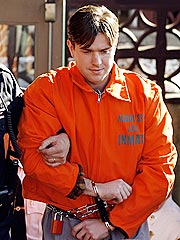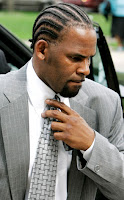 by Michele McPhee
by Michele McPhee e wall, just shy of his height. Entwistle was issued state-owned sheets, a pillow, and a blanket. The cell has a metal footlocker; a desk; and stool and one metal shelf hanging on the wall. He will be completely isolated with no contact with the general population at the prison, said Cara Savelli, a spokeswoman for the DOC.
e wall, just shy of his height. Entwistle was issued state-owned sheets, a pillow, and a blanket. The cell has a metal footlocker; a desk; and stool and one metal shelf hanging on the wall. He will be completely isolated with no contact with the general population at the prison, said Cara Savelli, a spokeswoman for the DOC. enacts the murder. He jammed the door of Geoghan’s cell with a paperback book so correction officers could not stop him. He punched the priest in the face. The priest fell to his knees at which point Druce (pictured left) bound his hands behind his back with a white T-shirt. Druce pushed the priest to the floor, face down and proceeded to strangle him with a tube-sock tourniquet that he tightened with the priest’s own sneaker.
enacts the murder. He jammed the door of Geoghan’s cell with a paperback book so correction officers could not stop him. He punched the priest in the face. The priest fell to his knees at which point Druce (pictured left) bound his hands behind his back with a white T-shirt. Druce pushed the priest to the floor, face down and proceeded to strangle him with a tube-sock tourniquet that he tightened with the priest’s own sneaker.
Monday, June 30, 2008
"Life" for Neil Entwistle Means Death in Prison (One Way or Another)
Sunday, June 29, 2008
The Anthrax Suspect the FBI Refused to Investigate
My suspect evolved following a FOX interview I gave in which I profiled the Anthrax suspect. I believe I said something along these lines:
1. He would be connected with Rutgers University in New Jersey or the area surrounding it.
2. He would be extremely obsessed with the media and politics.
3. He would have written many letters prior to the Anthrax attacks to editors of newspapers and politicians telling them answers to world problems and getting miffed he was not receiving proper responses to his "helpful" opinions.
4. He would ride the train between Trenton and Baltimore/Washington DC.
5. He would have some strong connection to America Media, where the first Anthrax letter hit.
A few days after this interview, I received the first of two letters, addressed in block handwriting and containing copies of bizarre letters to the media. Much of the content was how to solve crime and political problems.
The signature had been left off. The name of the sender was a fake, as was the return address in Tom's River, New Jersey. It wasn't until I ripped open the envelope (in my car) and then saw the label, I realized it could be the Anthrax guy. I battled with 
I survived the contents of the two letters and I was able to track down the writer. Here's what I found:
1. He was connected with Rutgers University in New Jersey. He was a Ph.D. in Biology working with soil.
2. He was extremely obsessed with the media, politics, and crime.
3. He had written many letters prior to the Anthrax attacks to editors of newspapers and politicians telling them answers to world problems and getting miffed he was not receiving proper responses to his "helpful" opinions.
4. He rode the train between Trenton and Baltimore/Washington DC where he had relatives. He did not drive.
5. He had a strong connection to America Media, where the first Anthrax letter hit. He was a regular subscriber to their Star tabloid magazine.
Furthermore, the man had many psychopath traits including pathological lying and grandiose ideation. He claimed previously to coworkers that he had worked covertly with the military to fight insurgents in Nicaragua and that after 9/11 the government had helicoptered him down to Washington, DC as part of a special undercover team of agents on a secret mission.
He also had a mentally unstable girlfriend over at Princeton, who used to be a student at Duke. She also was a Biology Ph.D. The Anthrax letters were dropped in a mailbox near Princeton University.
Am I saying my suspect is absolutely the Anthrax UNSUB? Of course not. But I will tell you that if you put his profile and links up against Stephen Hatfill, I would have sent 99 agents to check this guy out and let the other one see if he could find anything of note to justify a further look at Hatfill.
Friday, June 27, 2008
Prosecutors Control The Courtroom; Parents Control the Home
 by Robin Sax
by Robin Sax H
earsay: “It’s Not Fair! Mom!”W
ho said that? Paris Hilton, after a judge ordered her to return to jail immediately to serve out the rest of her sentence for violating her probation.Conventional wisdom suggests that judges control the courtroom. After all, they wear the black robes, sit in elevated chairs behind imposing desks, and insist that everyone refer to them as “Your Honor.”
But as trial lawyers well know, it is the prosecutors who are most in control of the criminal justice system and, by extension, the courtroom.
P
For instance, in mandatory sentencing schemes outlined in specific crimes, a judge’s sentencing options are limited by mandatory minimum sentences.
Even if a judge feels that there are factors to warrant leniency, the mandatory sentencing schemes require the court to impose a set sentence. Without the prosecutor’s assent in altering the charges, the judge’s hands are tied.
The prosecutor’s initial filing decision reverberates throughout the length and breadth of the case. Once in trial, prosecutors are generally the more seasoned attorneys in the courtroom and in large part determine the conduct of trials.
J
ust as prosecutors “own the courtroom,” parents must “own the home.” There can b e no doubt as to who is in charge. While each member of the family plays a part in the makeup of the family unit, the “law” within the home must be determined by the parents. There are a number of telltale signs to answer the “who is in charge” question. For example, take a look around your house. Is your family room overflowing with toys? Is your hallway filled with kids' shoes and balls? Is your kitchen table cluttered with yesterday’s homework assignments? Are you resigned to rationalizing that “my house will be clean when my kids are in college” and accepting the status quo of a kid-dominated house?
e no doubt as to who is in charge. While each member of the family plays a part in the makeup of the family unit, the “law” within the home must be determined by the parents. There are a number of telltale signs to answer the “who is in charge” question. For example, take a look around your house. Is your family room overflowing with toys? Is your hallway filled with kids' shoes and balls? Is your kitchen table cluttered with yesterday’s homework assignments? Are you resigned to rationalizing that “my house will be clean when my kids are in college” and accepting the status quo of a kid-dominated house?Are weekends spent at birthday parties, on soccer fields, dragging kids from one activity or play date (a loathsome phrase) to the next?
Was the last vacation you had without kids your honeymoon, ten years ago?
When you are at a business lunch, do you excuse yourself to go to
 the “potty”? Do you wipe the crumbs off your colleague’s face? . . . Do you find yourself listening to Barney when you are in the car alone? . . . These all may be signs that you have allowed your children to take too much control of your home, your life, and your existence. This is not to suggest that children should not take a great deal of a parent’s time, energy, and focus. Nor does it mean that parents shouldn’t adapt their homes, lives, and lifestyles to the needs and development of their children.
the “potty”? Do you wipe the crumbs off your colleague’s face? . . . Do you find yourself listening to Barney when you are in the car alone? . . . These all may be signs that you have allowed your children to take too much control of your home, your life, and your existence. This is not to suggest that children should not take a great deal of a parent’s time, energy, and focus. Nor does it mean that parents shouldn’t adapt their homes, lives, and lifestyles to the needs and development of their children.However, whatever choices and changes that are made should be conscious decisions, made affirmatively by the parent and not merely at the whim of a crying, whining, or nagging child.
If a parent feels that it works better to have toys strewn about a family room, so be it. If a parent chooses not to vacation until the children are in college, fine. But don’t complain about it because you are the boss! Parents must make the decisions and establish the parameters in their house according to what they see fit. No matter how annoying it is, “because I said so” is so.
Wednesday, June 25, 2008
Witness
 by Jenna Jackson I got an email a few days ago that made me start thinking about something I have not thought about in years. Executions.
by Jenna Jackson I got an email a few days ago that made me start thinking about something I have not thought about in years. Executions.A group called the Texas After Violence Project e-mailed to ask me to interview with them about my experience with the death penalty. Thankfully, I’ve never lost anyone I love to murder – or to an execution. But as a young reporter, I witnessed more than 20 lethal injections.
When I was in college at Sam Houston State University, I worked full time at the local newspaper, the Huntsville Item. I got some of my best reporting experience to date at that tiny paper. Even though it was a small paper in a small town, we covered big issues – because it’s located in the state’s prison capital – Huntsville, Texas.
I worked the prison beat, and part of my beat included covering executions at the nearby Walls Unit. I was 20 years old – and I spent many evenings at the old brick prison. It was usually just the same handful of us there – me, an AP reporter and a UPI reporter. Most nights, just before 6 p.m., the three of us would follow the prison PR guy across the courtyard and into the death chamber. Outside the gates of the courtyard, it would be silent. Every so often, an execution would garner publicity – and the street just outside that gate would be packed with people … protesting or just watching.
But most of the time, an execution was a non-event. That always struck me as one of the strangest parts of this ritual. I was a reporter covering a story – so I never voiced my opinion on whether I thought the death penalty was right or even effective. But I did always think if someone was going to be killed – whether at the hands of another person or by the state – it should be noted.
And because of that, our paper’s policy was that we published a story on each and every execution. Some weeks, there were several. On a couple of occasions, there were two in one night.
Because of those many nights I spent watching men be put to death, I actually came to believe that executions should be public. We as a society condone them – and we should see the effects of those laws. I’m not even sure it would change people’s minds to see them – but I think the option should be there.
But as it stands now, there are only a handful of people allowed into the death chamber to witness an execution. The inmate can choose a couple of people to come in on his side of the partitioned chamber – and the victim’s family can have a few people on the other side. The reporters usually were ushered into whatever side was the least crowded.
There was one night in particular that I remember where we three reporters were the only people – apart from prison staff – who were witnessing the lethal injection. The man strapped to the gurney had killed an entire family, so there was no one left on the victim’s side to attend. And he apparently had no family who was invited or wanted to come see him die. That was one of the saddest nights – simply because there was no one left to care whether this man lived or died.
When I got the e-mail from the Texas After Violence Project, I thought I really didn’t have much to tell them. I witnessed several executions, but I was never personally involved in any of these cases. But after thinking about it, I guess it affected me more than I knew at the time.
Their web site says the project was formed in 2007 “to listen.” As a reporter, I’ve always thought the more information people have, the better off they are – so, although I’m not sure what I can add to this project, I am going to call and tell them what I know.
Tuesday, June 24, 2008
GITMO Ruling: Supreme Court Got It Right
I
t is not a "get out of jail free" card. When our forefathers drafted the United States Constitution in the mid- to late-1700s, they agreed that no longer would the citizens of our new United States be held without bail, or without "due cause." This constitutional bedrock was instituted to assure that the Government could not pick up citizens and throw them in jail or prison without the prisoner having some recourse. That recourse is habeas corpus.My understanding of the Boumediene ruling by the Supreme Court is that it simply allows the Gitmo prisoners the right to habeas corpus, entitling them to the right to file a document that demands an answer to this core question: Do you (Government) have the legal right to keep me in prison?
I have heard people are outraged at this ruling. Our Republican presidential nominee, John McCain, was vocal in his criticism of the Supreme Court ruling stating the decision was "one of the worst decisions in the history of this country." Perhaps he believes that this decision should be in the same category as the Dred Scott decision, which upheld slavery, and Plessy v. Ferguson, which permitted separate but equal accommodations for races.
In actuality, the Supreme Court only gave the Guantánamo prisoners the same right that any person would want if they, or one of their loved ones, were arrested and placed in jail in another country.
The problem with that belief is that most countries do not have this thing called "habeas corpus." Many countries CAN arrest you--a citizen of the United States of America--and throw you in jail. What recourse do you have to assure that you are not languishing in jail for years before anyone decides your fate? I would bet that habeas corpus is not one of them. Remember the movie Midnight Express? That harrowing film about an American who was locked away in a Turkish prison was based on a true story.
So before you join the ranks of the uninformed citizens criticizing our Supreme Court, stop and think for a moment. Is it not OK for an inmate in a foreign country to have the right to ask "what are my charges and do you have enough evidence to hold me here?"
Guantánamo is an unacceptable legal black hole. Our U. S. Supreme Court simply said to all of us that we are a nation committed to the rule of law--not the rule of men.
TweetTim Russert's Impact on My Generation of Journalists
 Hunt for Justice by Cynthia Hunt
Hunt for Justice by Cynthia HuntThere is no justice in Tim Russert’s sudden death.
Tim Russert took over "Meet the Press" while I was in J school, and he has schooled me every Sunday morning since.
Tim Russert’s Enduring Legacy to Journalism
He showed me how to interrogate sources in a respectful, fair, yet aggressive manner. He taught me to dig. He taught me to prepare, prepare, prepare. Yes, he also taught me that it’s okay when your hair looks like a mess as long as you are working hard.
Russert’s lessons were especially important when I covered crime. Those stories involved the greatest of human tragedies: the unnecessary taking of innocent life and the rendering of justice. Justice here in Harris County, Texas courtrooms centers around a lot of capital crime and the rendering of a lot of capital justice. Harris County is the death penalty capital of the United States. If the county seat of Houston were ranked as a state, it would rank third behind Texas and Virginia in executions.
The "Russert Effect" on my Crime Reporting
Russert’s example of the difference a hard-working journalist can make was a weekly reminder for me to dig more.
After covering the Andrea Yates case, I believe the probing of dedicated journalists--who refused to take what officials and family told them as fact--ultimately led to justice. Yates is the Houston, Texas mom who drowned her five children in the family bathtub in 2001. The district attorney ignored overwhelming evidence that she was insane and pursued the death penalty to the outrage of many.
In 2002, a Harris County jury convicted her but sentenced her to life instead of the death penalty. An appeals court overturned that conviction because the state’s fifty-thousand dollar witness, Dr. Park Dietz, lied on the stand. Two years ago, Yates was tried again and found not guilty by reason of insanity.
I truly believe journalists and our efforts to dig on the Yates story educated the public and led to ultimate justice. For my part, digging led to an exclusive about the subjugation of Andrea by her husband's traveling preacher who repeatedly told Andrea she was falling short and destined for hell. Yates's psychosis manifested in the belief that she was so damned that her children would be punished for eternity.
Evidence shows that she was seeing and hearing messages that did not exist but which reinforced her bizarre belief that the devil was after her children. I uncovered actual video of this preacher with a devil’s mask harshly preaching that very message of condemnation. Even though attorneys had this self-proclaimed preacher’s newsletters, seeing the video was a much more powerful lesson for the public.
I reported the story on my Houston station and on Good Morning America. I was proud that on a national story a little digging by me, a local journalist, helped uncover a small yet important piece of the puzzle. It was these kinds of pieces that ultimately painted the picture of what happened inside that house to a once loving and patient mother of five.
Go Ahead - Light My Fire, Tim
My Sunday mornings with Tim often reignited my fire to spend my nights and weekends off doing the most important work—hunting for the truth. In these days of flash-bang television television and print journalism, good-old fashioned digging is often overlooked. News managers hungry for one reporter to fill spots during two to three newscasts per day simply don’t give reporters the time it takes to uncover the real story. We in the business know it takes many hours of our personal time to deliver this to the public. Russert’s discipline and dedication to his craft wouldn’t allow him to cheat our nation of his best. After his death, friend after friend explained how Russert never went out on Saturday nights because he was always preparing even more for his Sunday morning symphony of cutting questions.
Russert’s discipline and dedication to his craft wouldn’t allow him to cheat our nation of his best. After his death, friend after friend explained how Russert never went out on Saturday nights because he was always preparing even more for his Sunday morning symphony of cutting questions.
And boy, did he make a difference. When I heard the news of his passing, I truly felt as if I had lost a mentor even though I had never met him. I cried the entire weekend and watched every single special anyone did on this great journalist and great man. I must confess that I feel unworthy now writing about what he meant to me and our shared passion, journalism.
Some Say Russert Coverage Overblown
Some journalists and pundits have blasted the wall-to-wall coverage of Russert’s death saying it was overblown. I say we need more stories like that—stories of great Americans who set an example for all to follow.
In newsrooms, where young, passionate, idealistic journalists are slowly turned into cynical, burned-out machines, I say we need more in-depth coverage of great Americans like Russert to remind us that individual effort is not only crucial but it’s the most important thing.
I cannot think of another journalist who would have received that kind of coverage. Russert had a unique spirit that won the respect and love of Americans. That universal feeling of loss to our nation justified the coverage.
It was appropriate to shine light on Russert's life as an enduring symbol of opportunity in our country. His legacy reminds us all that in America it doesn’t matter where you start. It matters where you end. Russert was raised the son of a simple sanitation worker in Buffalo, New York. I grew up in Alabama on a dairy farm in the small town of Eva (population 438). Tim’s ascendancy to the top of network news served as a constant reminder of what one can achieve in this nation with a mighty heart.
In a shallow world where constant coverage of Britney, Paris, and Lindsay rots away at our souls, the story of Tim Russert’s life helps many of us regain our passion and our perspective.
You know, I was wrong. There is justice in the passing of Tim Russert. His work created the most powerful closing argument on what a journalist should be. His life gave us the verdict that yes, the efforts of one matter greatly.
On the first "Meet the Press" since Russert's death, NBC played a video tribute which ended with a shot of the capital after the funeral. There was a magnificent, bright rainbow arching across the giant Beltway sky. Go get 'em, Tim.
Monday, June 23, 2008
New Life for a Closed Case
That morning before he left his house, he took his vitamins and talked about coming home early to cut the grass and clean the pool. He said he wanted to spruce the place up before they put it on the market.
Police were tightlipped about their investigation but did say that Shue apparently was “abducted and somehow abused.” Kendall County Sheriff’s investigator went so far as to say that Shue was not in control of the car when it crashed.
No one was surprised when Bexar County Medical Examiner Vincent DiMaio issued an autopsy report declaring that Shue died from head injuries, including multiple skull fractures, caused by the collision. But many were stunned when DiMaio said that Shue’s wounds were self-inflicted and he committed suicide by deliberately running off the road. Tracy Shue, Philip’s friends and colleagues including the fellow psychiatrist who provided counseling to Shue refused to believe that conclusion. Nonetheless, the grand jury backed the medical examiner’s finding.
Tracy hired Forensic Pathologist Cyril Wecht to perform a second autopsy. He released his report in April 2004. He wrote: “I do not agree that this death can be simply labeled as a suicide. It is more likely that another person(s) played a role in his death.”
There was a cell phone in the car and Shue did not call for help. DiMaio believed this reinforced the ruling of suicide. Wecht contradicted that assessment writing that the face of the phone was bloody indicating that Shue may have attempted to use it.
Tracy filed claims against the two insurance companies who carried policies that named ex-wife Nancy Shue as the beneficiary.
Finally, in June 2008, her negligence claim against USAA Life Insurance Company entered the courtroom. In civil court, Kendall County Court at Law Judge Bill Palmer, after listeni ng to testimony and reviewing 2,100 exhibits, cleared the insurance company of negligence but he also issued a statement that Shue’s death was a homicide.
ng to testimony and reviewing 2,100 exhibits, cleared the insurance company of negligence but he also issued a statement that Shue’s death was a homicide.
As Tracy left the courtroom, she said: “That’s all I ever wanted. It’s been all about the truth.”
Now District Attorney Bruce Curry needs to decide if he is going to bring the Judge before the grand jury to explain his reasoning. It’s time to re-open the investigation into Philip Shue’s death.
Friday, June 20, 2008
A Singular Event
Mothers Who Kill
 by Lucy Puryear, M.D.
by Lucy Puryear, M.D.I can imagine few things more horrific than a mother killing her own child. Mothers are warm, kind, nurturing people who would rather die than have anything happen to one of their precious children. But as we know all too well mothers do kill, and unfortunately it's all too frequent.
There are mothers who kill because they want
 revenge against their boyfriends or because they are desperate to keep the man they love. These women, like Susan Smith, the mother who drowned her two children in the lake while they were asleep in their car seats, are criminals. Although women like Smith (pictured right) may have many mitigating circumstances that make them feel desperate and alone, all of them have alternative choices besides killing.
revenge against their boyfriends or because they are desperate to keep the man they love. These women, like Susan Smith, the mother who drowned her two children in the lake while they were asleep in their car seats, are criminals. Although women like Smith (pictured right) may have many mitigating circumstances that make them feel desperate and alone, all of them have alternative choices besides killing. It is believed that this was an example of altruistic filicide, motivated by a mother's love and her belief that her children's deaths were better than leaving them in this world without a mother. Were this woman to have lived she would have been tried for murder, but is she the same type of criminal as the examples above?
 Today is the seventh anniversary of the Yates children's death at their mother's hand on June 20, 2001. She was tried, convicted, and sentenced to life in prison with the option of parole after 40 years. Due to non-factual testimony by Dr. Park Dietz, the State's highly paid expert, Andrea Yates was given a new trial five years after her original conviction. This time the jury found her not-guilty by reason of insanity. She was sent to a maximum security state psychiatric facility in Vernon, Texas. She was no longer a criminal.
Today is the seventh anniversary of the Yates children's death at their mother's hand on June 20, 2001. She was tried, convicted, and sentenced to life in prison with the option of parole after 40 years. Due to non-factual testimony by Dr. Park Dietz, the State's highly paid expert, Andrea Yates was given a new trial five years after her original conviction. This time the jury found her not-guilty by reason of insanity. She was sent to a maximum security state psychiatric facility in Vernon, Texas. She was no longer a criminal.What few realize is that Ms. Yates remains under the jurisdiction of the courts. Although no longer in maximum security, she will remain in a state hospital until a judge determines that she is no longer a danger to herself or others. Even if she were well this is unlikely to happen.
So why rehash the Andrea Yates case? Yes, I testified that she was psychotic at the time of the drownings (hearing voices speaking to her from the TV, believing that she was invaded by Satan and that he was trying to ruin her children through her and send them to hell) but I've had many arguments with others who believe that although mentally ill, she was responsible for the killings and should be punished. I'm not going to continue to try to change the minds of others about this particular case.
It is estimated that between 1 and 2 women per 1000 deliveries will develop postpartum psychosis. This is a psychiatric emergency. The psychotic thoughts revolve around the baby and often include thoughts of harming the child and themselves. The only way to treat these disorders is through prompt diagnosis and medical treatment. A mother who is psychotic should never be left alone with her child.
 On June 4-7, 2008, Houston was host to the 22nd annual conference of Postpartum Support International. Supported by the Yates Children's Memorial Fund (YCMF) of Mental Health America of Greater Houston (MHA) and Texas Children's Hospital, over 300 attendees heard lectures about about postpartum psychiatric disorders, their recognition and treatment. The more we educate health care providers, mothers, and those who love them the more lives will be saved. The more we talk the more mothers will feel safe to speak out loud the confusing feelings they are experiencing. The more we destigmatize postpartum psychiatric disorders and make it safe to ask for help, the fewer tragedies will end up on the front page of the newspaper.
On June 4-7, 2008, Houston was host to the 22nd annual conference of Postpartum Support International. Supported by the Yates Children's Memorial Fund (YCMF) of Mental Health America of Greater Houston (MHA) and Texas Children's Hospital, over 300 attendees heard lectures about about postpartum psychiatric disorders, their recognition and treatment. The more we educate health care providers, mothers, and those who love them the more lives will be saved. The more we talk the more mothers will feel safe to speak out loud the confusing feelings they are experiencing. The more we destigmatize postpartum psychiatric disorders and make it safe to ask for help, the fewer tragedies will end up on the front page of the newspaper.Andrea Yates was not a woman destined to be a killer. She came from a good family, was highly educated, and loved her children enormously. It could have happened to you or me or to any other woman who delivered a baby. Society let her down. Doctors let her down. Our criminal justice system initially let her down.
Thursday, June 19, 2008
It's Been a Long Week of Asking, "Why?"
"It's been a long night of wondering, Why? - Why would somebody do this?"
This was the question asked by Stanislaus County Sheriff's Deputy Royjindar Singh in Turlock, California on Saturday, June 14th after a man, 27-year-old Sergio Casian Aguilar, stomped and kicked his two-year-old son to death on a remote country road. What makes this story even more horrific is that several passersby stopped and attempted to save the child.
T
he man responsible for the toddler's murder had stopped his truck in the middle of the road and had drug the toddler behind it to commence a fatal beating. The man was so enraged and focused in this beating that anyone who tried to physically stop him from furthering the assault was promptly thrown onto the ground before the man went back to beating the baby. According to the witnesses, the man was screaming, "Demons are in him!"A sheriff's department helicopter carrying a deputy landed at the scene where the man was fatally shot after refusing commands to stop beating the child. It was entirely too late for the toddler. His beating was so severe he would only be able to be identified through DNA and dental records. Everyone, including the deputy, who was subjected to this barbaric act will no doubt have a lengthy period of trauma ahead.
This is the second time in one week we are asking, Why?
As if the above, stomach-churning ordeal wasn't enough, we have been updated everyday on the two
Oklahoma children who were shot to death six days prior to the toddler's beating.L
ast Sunday, Taylor Paschal-Placker, 13, and Skyla Whitaker, 11, decided to take an afternoon walk along a county road in an unassuming small town in Oklahoma. Less than twenty minutes later, the girls (pictured below) were shot to death, their small bodies found lying on the road.T
hough this act has incensed and frightened parents across the nation, no one has been arrested and little evidence was left at the scene. What animal, monster, or sub-human creature could possibly shoot multiple rounds into two innocent children?
M
aybe the girls did what they were supposed to do when approached by a stranger. It's what we all teach our children about "stranger dangers": run, scream, kick, bite, and fight if you have to. Maybe the suspect panicked as one of the girls grabbed her cellphone while he held onto the other. Maybe.Recently released information revealed that two guns were used in the brutal slaying, indicating to some that there were two suspects. Possible, but not absolute. A single-shot shotgun, which can be loaded very quickly, only holds one round--one for each girl.
In this scenario, I envision the suspect throwing the shotgun to the side, and picking up his handgun and unloading the magazine into each of the girls, angry and panic-stricken that he came so close to getting caught. Again, just maybe.
The last theory clearly concerns and terrifies residents in the area: That this was a random act of violence; that the suspect/s blatantly and without reservation drove by and shot the innocent girls for no reason. If this proves to be the correct theory, I strongly advise the people in the community to lock all doors and windows, and hold your children tight. Whoever is responsible will undeniably strike again.
 Several witnesses in the area reported seeing a man (composite at right). This man was described as an American Indian, possibly half-Caucasian, around 35 years old and standing six feet tall, his black hair pulled into a ponytail. Witnesses described him in or near a white single-cab pickup with chrome striping and Oklahoma tags.
Several witnesses in the area reported seeing a man (composite at right). This man was described as an American Indian, possibly half-Caucasian, around 35 years old and standing six feet tall, his black hair pulled into a ponytail. Witnesses described him in or near a white single-cab pickup with chrome striping and Oklahoma tags. The reward for information on this violent atrocity is now up to $40,000. I urge anyone with information to come forward. If you believe this man to be a family member please know that all will be done to protect your identity, but the families of the victims need closure, and a town needs to be at peace.
It seems that we have embarked on unfamiliar territory in society as parents or just as human beings. Whether the news coverage of these horror stories is becoming more prevalent or the vicious acts themselves are on the rise, we can always count on that one question coming to mind:
Why?
Wednesday, June 18, 2008
Hollywood (In)justice - The Show Must Go On . . . Even When Celebrities Are Guilty
Isn't it ironic that R. Kelly's acquittal, on charges that could have brought him fifteen years in prison, by the way, comes just as HBO began airing its documentar y "Roman Polanski: Wanted and Desired," which basically chronicles the charges brought against Polanski (pictured right) for having sex with an underage girl. Also thirteen years old, by the way. In that case, the intense media glare scared the victim so badly, she didn't want to testify.
y "Roman Polanski: Wanted and Desired," which basically chronicles the charges brought against Polanski (pictured right) for having sex with an underage girl. Also thirteen years old, by the way. In that case, the intense media glare scared the victim so badly, she didn't want to testify.
Prosecutors in the 1978 case were willing to deal, dropping a laundry list of charges, including rape and supplying a minor with drugs and alcohol, but left unlawful intercourse with a minor. Polanski pled guilty, but fled the country, fearful that a media-adoring judge would sentence him to hard prison time. I think most people agree the judge in the case was a man driven more by reporters and public opinion than his law books.
Still, I wonder if Polanski follows celebrity court cases in the United States today. And as he watches stars walk away from charges ranging from murder to child pornography, if he considers what would've happened if his case had been in a California court today. A media-obsessed judge would be irrelevant. All he'd need to set him free is your average, celebrity- obsessed jury.
TweetTuesday, June 17, 2008
Stacy Dittrich on Nancy Grace!
"
I was sworn in as an auxiliary," she explained to WCI, "so I still get to carry a badge and gun. Whew."N
owadays her fingers will be on the keyboard more than her crime-fighting arsenal as Stacy embarks on a career as a full-time writer. "This was what I worked so hard for and finally made it," she said. "I'm loving this stay-at-home stuff--except I've been busier than I've ever been in my whole life." She's not kidding. Stacy just returned from BookExpo in Los Angeles. Two of her crime novels are scheduled for publication in the next year, the first in October. And she also has a contract for her first hardcover true-crime book. A memoir is in the works as well.
her crime-fighting arsenal as Stacy embarks on a career as a full-time writer. "This was what I worked so hard for and finally made it," she said. "I'm loving this stay-at-home stuff--except I've been busier than I've ever been in my whole life." She's not kidding. Stacy just returned from BookExpo in Los Angeles. Two of her crime novels are scheduled for publication in the next year, the first in October. And she also has a contract for her first hardcover true-crime book. A memoir is in the works as well. T
his past spring, Stacy's agent received a call from the Academy Award-winning producer of the movie The Devil Wears Prada. Hollywood is interested in a screen adaptation of Stacy's debut novel. The Devil's Closet is first in the CeeCee Gallagher detective series. The protagonist was patte rned after Stacy, who was a detective specializing in sex crimes.
rned after Stacy, who was a detective specializing in sex crimes. S
tacy's hometown newspaper has chronicled the adventures of their local girl made good. Click here for a link to the story in today's Mansfield News Journal, which includes current news on Women in Crime Ink.M
ake sure to tune in to Nancy Grace tonight to catch Stacy Dittrich in her first TV appearance since retirement.Let's Make a Deal? Maybe.
 by Kathryn Casey
by Kathryn Casey Okay, the truth? I have no compassion for Susan Atkins. A
It wasn't until years later, in front of a parole board, that Atkins finally expressed remorse. Known within the family as Sadie Mae Glutz, Atkins was the one who scrawled the word "PIG" in blood on Tate's front door. In addition, she has pleaded guilty to the murder of music teacher Gary Hinman.
Now the wrinkle: Atkins is dying.
As I reported in an earlier WCI post, according to the Manson Family Today Web site, she's had a leg amputated and suffers from terminal brain cancer. Prison docs reportedly predict that she has less than six months to live. Atkins is the longest-serving woman inmate in California, and she's been turned down for parole eleven times. On her behalf, Atkins' husband/attorney, James Whitehouse, has filed a compassionate release request, hoping the California parole board will grant his wife the mercy she denied her victims. Whitehouse wants Atkins to live out her remaining time outside prison walls.
So what do you think: Should Susan Atkins' approaching death earn her a "Get out of Prison Free" card?
My opinion? No. Lots of folks die in prison, sadly some--based on the rash of convictions overturned by DNA--who shouldn't even be there. Why would anyone make an exception for Susan Atkins?
Debra Tate, Sharon's sister and only living relative agrees: "I don't want to seem like a heartless creature. But in all my years, I never considered this could happen. This is a serial killer, and what kind of mercy did she show her victims? When you torture someone, you have no compassion. How do you ask others to give it to you? It is her duty, in order to pay for her crimes, to die in prison."
It's actually surprising that Atkins is still alive. As you may remember, she along with Manson, Leslie Van Houten, Charles "Tex" Watson, and Patricia Krenwinkle were all sentenced to death for their roles in the Tate-La Bianca murders. They're alive today only because a 1972 Supreme Court ruling temporarily quashed the death penalty, and their sentences were commuted to life.
So there it is, my opinion and I'm standing by it. Still, and I know this sounds like a full 180, I'm not totally against the granting the "compassionate release." That is, under certain conditions.
Without extenuating circumstances, it seems unlikely that Atkins will get out. Compassionate releases are rare in California. Only 10 of the 60 requests made in 2007 were granted. The odds are that, without a good reason to do otherwise, the state parole board will review the Atkins request and file it in the not-gonna-happen basket. Why would I suggest that maybe this is a request that could be considered?
My stance has nothing to do with the fact that Atkins now presents herself as a born-again Christian. When she takes that final breath, God--not man--will judge if she's repented and deserves forgiveness. And even if she's truly sorry, it doesn't excuse her heinous crimes.
Believe me when I say that I wouldn't suggest releasing any of the other Manson murderers. Van Houten, for instance, has been repeatedly up for parole and turned down each time. As Superior Court Judge Bob Krug said, while Van Houten is described as a model prisoner, the nature of the crimes was the "basis on which the board based its decision" to deny parole. Let's face it: The Tate-La Bianca murders are too gruesome to be forgotten.
So why consider granting Atkins a release? Because we're not talking about a lot of time here, only a matter of months, and there's something Atkins could do for us, all of us, especially the families of unknown victims, that might be worth allowing her to spend her final time outside prison walls. Staring death in the eye, assuming she's still lucid enough, Atkins has the opportunity to ease the pain of others, by giving authorities the details and burial locations of any and all other Manson family victims.
 As Atkins withers away from cancer in the California Institution for Women, law enforcement authorities and forensic experts continue to eye the Barker Ranch in Death Valley, where the Manson family lived at the time of their arrests. For more than three decades, rumors have persisted that the clan committed murders at the ranch. Bodies, however, have yet to be found, even after repeated searches. Why do we care? If there are undiscovered bodies, there are families living in pain, moms and pops and brothers and sisters, perhaps husbands and wives and sons and daughters who may still hope every day that their long-lost loved one will walk back into their lives. Don't they deserve to know what really happened?
As Atkins withers away from cancer in the California Institution for Women, law enforcement authorities and forensic experts continue to eye the Barker Ranch in Death Valley, where the Manson family lived at the time of their arrests. For more than three decades, rumors have persisted that the clan committed murders at the ranch. Bodies, however, have yet to be found, even after repeated searches. Why do we care? If there are undiscovered bodies, there are families living in pain, moms and pops and brothers and sisters, perhaps husbands and wives and sons and daughters who may still hope every day that their long-lost loved one will walk back into their lives. Don't they deserve to know what really happened? I
'm not suggesting a quid-pro-quo. The parole board shouldn't offer Atkins a guaranteed ticket out of prison if she discloses information. But I am suggesting that perhaps Atkins, the self-professed born-again Christian, might want to relieve her soul and repent all her crimes before departing this earthly plane. Why not come clean and tell authorities where the bodies are buried? Isn't that more Christian than taking that information to her grave and depriving the victims' family members of long-awaited answers?I
f and when Atkins finally puts to rest the mystery surrounding Barker Ranch and any other Manson clan burial sites, perhaps the members of the California parole board will find it in their hearts to grant her the mercy she's requesting. Perhaps they will believe that she has truly changed.A
tkins needs to move fast. Her condition sounds precarious, and July 15th is the soonest the board can review her request. Even if fessing up doesn't win her a release, Atkins could die knowing that she's finally taken a step toward making some small amends for her horrific crimes.Monday, June 16, 2008
How Children Become Expendable
A while back I went to see We Are Marshall, a movie about the horrifying plane crash that killed an entire football team and their coaches in 1970. Because the film was a typical Hollywood flick, we hardly got a few minutes to meet some of the players and their families before the airplane crashed. I spent the rest of the movie not feeling all that sympathetic to these devastated families or to the girlfriend of one of the players, whom we follow for the rest of the film, watching her pick up the pieces. I can't recall what any of them looked like and, when the movie was over, I tossed my popcorn in the trash and the movie quickly flew out of my mind.
On the other hand, after I saw an Indian movie called Yun Hota Toh Kya Hota (Rough translation: What if . . . ?), I cried when the plane crashed into the World Trade Center and all but one of the main characters died. I am still bothered by this movie and I can picture all of the protagonists and remember the looks on their faces in the last moments of their lives. Why the difference?
Well, Bollywood does something Hollywood does not: they spend an immense amount of time in character development during their movies, so by the time tragedy hits, you are fully invested emotionally in these people. They have become real to you and you know their hopes and dreams and it is horribly painful to see them suffer and lose out on their futures. We also get to know those who loved them and we feel terribly sad for them as well.
What does all this have to do with crime? A lot in a world that is spending less and less time in human interaction and more time in artificial worlds where humans are devalued and depersonalized.
Two little girls were just used as target practice out in the small town of Weleetka, Oklahoma. Police theo
 rize two shooters using different guns both shot each of the girls, 11-year-old Skyla Whitaker (pictured left), and 13-year-old Taylor Paschal-Placker (right). The two little girls were doing nothing more than walking from o
rize two shooters using different guns both shot each of the girls, 11-year-old Skyla Whitaker (pictured left), and 13-year-old Taylor Paschal-Placker (right). The two little girls were doing nothing more than walking from o ne house to the other in the middle of the day. They were not enemy combatants, they were not opposing gang members, and they did not get killed because they saw something they shouldn't have or wanted out of a romantic relationship. They were killed because they had no meaning to the killers except as moving targets. Their murderers had zero empathy.
ne house to the other in the middle of the day. They were not enemy combatants, they were not opposing gang members, and they did not get killed because they saw something they shouldn't have or wanted out of a romantic relationship. They were killed because they had no meaning to the killers except as moving targets. Their murderers had zero empathy.Zero empathy or great fear are the only two explanations for why human beings can take the lives of others. Great fear of children or harmless people cannot be justified, which leaves only zero empathy as the remaining answer. Fear and low empathy is achievable in war which allows soldiers to kill little children (especially those they think are attached to explosives). Low empathy is certainly present in terrorists who claim to have only killed children (as collateral damage) for a cause. But zero empathy is what is present in homegrown murderers who take lives of children merely for the fun of it.
I got a closeup view of zero empathy by a young adult toward children in action during a ride-along with my police officer daughter. We--and I say we because all of us ride-alongs feel temporarily part of the team!--were called to a public library at seven at night. Two little boys, six and eight, had just spent the last eight hours while Mommy was off with her girlfriends at an amusement park. She had dumped them there, without any lunch or snacks, and told them they would get picked up around 7 PM. The police beat Mom to the library. When Mom arrived, she was forced to sit while CPS was contacted. She complained the whole time about how long she had to wait . . . in all, about 45 minutes . . . and how she was hungry. Finally, the decision came down, and the children were placed in the police cruiser to be taken into protective custody.
Not once did the mother of these boys look at them, talk to them, or apologize to them. She only had concern for herself and for what she had to go through because "these cops were being ridiculous." Zero empathy for the little boys. One day if she decides she has had enough of having to "care" for them, we might find them dead.
Society will be surprised at how this could have happened! What kind of pressure must the mom have been under to do such a thing? Is she psychotic? Did she snap? No, folks, Mom has zero empathy and the boys are expendable. Zero empathy is the hallmark of psychopathy and psychopathy is a growing menace in the United States and elsewhere in the world.
Children and teens who grow up in an emotional abyss and are raised on media that devalues human life in quantity through violent television and video games show increasing signs of reduced empathy towards their families, classmates, and communities. Then these young people grow up to be teenage killers or full-grown adults who have no empathy toward anyone younger.
W
hen the two men who killed Skyla and Taylor are caught, we undoubtedly will hear from the defense lawyers as to what drove these men to kill innocent children. What we are unlikely to hear is that these two men simply have zero empathy for other human beings. Like rabid dogs with an incurable disease, human beings who have zero empathy are damaged beyond repair.Our country needs to take a strong look at what is causing young people to become emotionally estranged from their fellow man and work hard to restore in society what is necessary for creating love and empathy in our youth and remove what is detrimental to their healthy emotional growth. Otherwise, children will become more and more expendable in the eyes of those who feel nothing for them.






























